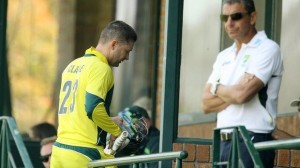
This summer’s World Cup should be Michael Clarke’s limited-overs swansong. But until then, he should be leading the team at every opportunity.
That Clarke has had to be prematurely flown home from Zimbabwe due to injury is not proof he should never have been risked in the first place for a tri-series of little importance for all bar impoverished Zimbabwe.
Yes, the captain became sore after the flight from Australia and complained of a tight hamstring, which ruled him out of the first two matches. But the captain often gets sore after long-haul flights, if not due to his hamstring then due to his problematic back.
To wrap Clarke completely in cotton wool whenever he felt less than perfect would ensure his record of only missing one Test due to injury – last year, in India – worsens considerably.
Clarke’s lofty credentials are well established. So why choose him for a minor series in Zimbabwe? Because with a World Cup just over five months away, the time for tinkering is over. Where possible, every match should be treated as a dress rehearsal.
Australia needs to be sure of its ideal batting line-up before the World Cup. Its batsmen also need to know how they can best complement Clarke.
As dashing as Clarke can be in Tests, in limited-overs he is generally a laggard in regards to scoring. The loss to Zimbabwe showed that is not necessarily a liability because of the big hitters around him.
That his strike-rate was below 70 before his injury-enforced retirement was acceptable because he was able to play the anchor role in the way no one else was able to.
The other anchor-type player in the line-up, Phillip Hughes, is at long odds to keep his spot once David Warner and Shane Watson return.
It is an annoyance for Australia’s home World Cup preparations that it will play this tri-series tournament without three of its likely top-four batsmen for the World Cup (only Aaron Finch is still there).
But selecting Clarke when it did was nevertheless a worthwhile gamble, especially so because of the presence of formidable South Africa in the series. With Warner and Watson already unavailable, to have sent home Clarke as a precaution would have been a sign of complacency.
Clarke will have five weeks to recover for the three-match one-day series against Pakistan in the United Arab Emirates. While it would not be a disaster if he was unable to play in those matches because of the vast difference in pitch conditions from the UAE to what will be served up during the home World Cup, it is still worthwhile that he aim to be fit for it.
But there should be a greater level of caution about clearing Clarke to play in that series because of the two Tests that follow. The importance of the captain, a masterful player of spin, to the outcome of the series is arguably second only to Saeed Ajmal, the Pakistan spinner whose bowling action is being investigated by the ICC.
Australia must strive for Clarke to play in all of the five home one-dayers against South Africa in the second half of November, even though the Tests against India come after them, and the tri-series against England and India just before the World Cup.
Clarke’s one-day retirement is necessitated by Australia’s looming packed Test schedule. Australia only plays six Tests before the next IPL tournament in 2015, which runs from April to June. But in the 10 months after that, plays 18, with an away Ashes complemented by away series in Bangladesh, the West Indies and New Zealand, and home series against the latter two.
Australia needs Clarke available for all of those Tests. Preserving him just for the red-ball game will give Australia and its captain a greater chance of achieving that.
Jesse Hogan
Sports writer




 Driving Naari Programme launched in Chandigarh
Driving Naari Programme launched in Chandigarh






























